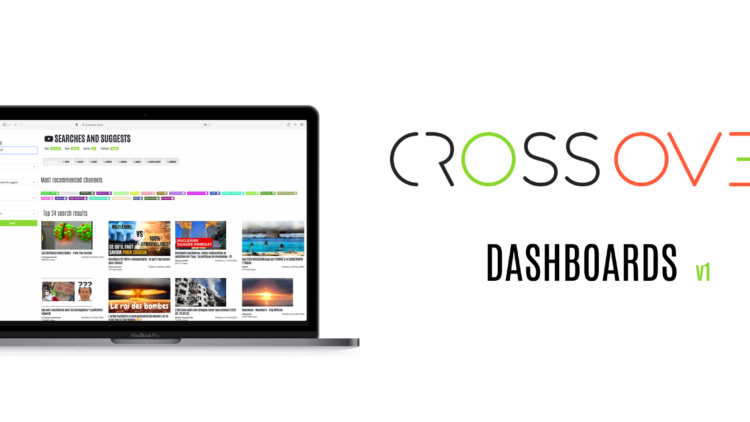See what algorithms recommend to Finns on Tiktok, YouTube and other platforms: CrossOver Finland dashboards are now live
Check First and the Finnish fact-checking organisation Faktabaari have developed a methodology that allows anyone to look under the hood of social media recommendation algorithms.
Social media algorithms have a huge impact on what we see online. They have the power to shape our perceptions of the world and influence our behaviour. Digital giants like Google, Meta and Bytedance, the owner of Tiktok, have traditionally been quite secretive about how these recommendation algorithms work in practice. The new Digital Services Act (DSA) requires platforms to be open with consumers about how their algorithms work, but how clearly they manage and communicate this is another matter.
Now, however, anyone can have a look at what algorithms suggest.
As part of Faktabaari and Check First’s CrossOver Finland project, dashboards are now available online, open to all and independently of the platforms being monitored. 100 keywords can be tracked on eight platforms and search engines used by Finns. The database can be found here.
Database shows what was recommended in the run-up to the presidential elections.
For the monitoring, computers simulating users living in different areas were sent to the homes of ten volunteers across Finland. The first computers started collecting data in December. The project will continue beyond the European elections until July.
The monitoring currently covers Tiktok, YouTube, Instagram, Google News, Mastodon, as well as search recommendations from Google, Bing and DuckDuckGo.
For example, the dashboards can be used to examine which political parties or channels were the most popular on YouTube in the run-up to the first round of the Finnish presidential election. Or what kind of content Google or Bing direct Finns to when they search for information on, say, election disputes or Russia, and whether these recommendations change over time.
In previous iterations in Belgium, for example, Check First has revealed that Youtube recommended the Chinese state-controlled news service CGTN to Belgian users when searching for content containing the word “Russia” (Russie). It was also found that when the word “dombass”, or Donbass in French, was typed into Google’s search engine, more than 99% of the time, Belgian users were recommended the Kremlin-funded “Donbass insider” website, which spreads Russian propaganda.
How our dashboards can be interpreted?
The dashboards landing page provides instructions on how to use the database and answers to some common questions in English. Use the bar on the left to select the social media platform or search engine you want to see results for.
The database provides a near real-time picture of social media recommendation algorithms across Finland. However, you should be careful when interpreting it and remember a few things:
- To avoid misinterpretations, read carefully what the dashboard and its different sections say they represent.
- Social media feeds look different to all of us because of the algorithms. The feeds are shaped by the data collected about us – our age, our gender, where we live, our past behaviour, our interests and how much time we spend online with each social media post.
- In the dashboards, data is collected in two ways: through APIs provided by the platforms themselves, and by simulating users living in different parts of Finland.
- The APIs tell us what is the official representation of the content recommendation as announced by the platform itself.
- The user simulation, on the other hand, shows what is recommended for a new user living in a particular region when, for example, they search Tiktok for videos with the word “elections” or Google for information with the word “voting”.
- This dual approach allows us to compare the information provided by the platforms with the concrete experiences of users. However, it is to you that social media may look different from what the database shows.
If you find something interesting in the dashboards that you would like us to investigate further, please let the Faktabaari or CheckFirst teams know.
Faktabaari’s editorial team, Check First and researcher Aleksi Knuutila are currently working on the database. During the project, two more extensive reports on our key findings will be published, as well as other findings on suspicious recommendations from the algorithms, as appropriate.
The dashboards will also help the Faktabaari editorial team monitor social media more effectively and systematically from a fact-checking perspective. However, there is a lot to follow in the database, and Faktabaari and Check First hope that the Finnish media outlets, researchers and other interested parties will be inspired to do their own research there and contribute to making visible the digital power that desperately needs more watchdogs.
A webinar was held on 8 February 2024 (in Finnish):
It is important to be able to illustrate the marketing logic of social media.
Faktabaari, as an independent actor in the field of digital information literacy, has long been reporting on the challenges digital platforms pose to citizens: the manipulative and polarising logic of digital power. Especially in the run-up to elections, it is important to try to monitor digital power.
Translated from Finnish. A blogpost by Pipsa Havula.
For more information:
Pipsa Havula, Faktabaari‘s managing editor, pipsa@faktabaari.fi
Guillaume Kuster, CEO of Check First, info@checkfirst.network
Founded in 2014, Faktabaari is a politically neutral fact-checking service and digital information literacy promoter that has won several awards for its work – most recently the State Prize for Information Disclosure (2023) and the Alfred Kordelin Prize (2023).
Founded in 2020, Check First is an internationally recognised player in the field of fact-checking, open source intelligence and disinformation. Check First is also one of the founding organisations of ObSINT, the Public Interest OSINT Guidelines.
This project has received funding from the European Media and Information Fund (EMIF), managed by the Calouste Gulbenkian Foundation.




